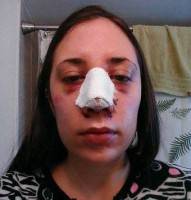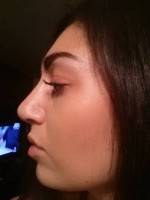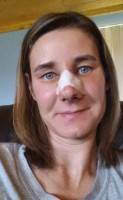Can Rhinoplasty Make Breathing Worse?
Breathing can become worse if conditions such as turbinate hypertrophy, a deviated septum or allergies are not recognized and addressed prior to or during rhinoplasty.
If surgery is performed to reduce the size of a nose, consequently the noses’ internal volume will be reduced.
This new volume must still permit good airflow dynamic. A facial plastic surgeon with an original background in ear, nose, and throat surgery can address these type issues prior to any rhinoplasty surgery. (William Portuese, MD, Seattle Facial Plastic Surgeon)
Trouble breathing after Rhinoplasty
Ideally that should not happen, but it can. The operation of the nose, is usually to make it smaller. If something is not done on the inside, breathing can be compromised.
That is a good reason to see a Facial Plastic surgeon who is trained in ENT (ear, nose and throat) or a Plastic Surgeon who specializes in nasal surgery.
I do not think you can be a proficient nasal surgeon without knowning how to do intranasal airway surgery. Its like building a house from the outside in, it just doesn’t work!.
In trying to make the nose smaller some surgeons aggressively remove too much cartilage which can also cause airway obstruction. As you can see, you need to do your homework when picking the right nasal physician to do your surgery. (Carlos Wolf, MD, Miami Facial Plastic Surgeon)
Well performed rhinoplasty should not affect breathing
It is important to thoroughly examine the nose before surgery and evaluate the functional component in addition to the cosmetic concerns that brought you to the consult.
The septum, turbinates and nasal valves all can affect nasal airway. A well performed rhinoplasty should improve the appearance of the nose while maintaining proper nasal airway patency.
If the nasal tip support and valves are weakened, these should be resupported. A good rhinoplasty result should be achieving your cosmetic goal while maintaining a good nasal airway. (Corey S. Maas, MD, San Francisco Facial Plastic Surgeon)
Can rhinoplasty make breathing worse?
Any rhinoplasty operation which makes the nose smaller can also worsen breathing. It is important to have a thorough discussion with your surgeon about the techniques that would be employed during surgery to minimize potential for nasal obstruction.
In general, the more that the nose is made smaller, the greater the risk for nasal blockage. Be sure that your surgeon has plenty of experience both in nasal aesthetics and nasal function. (Maurice M. Khosh, MD, New York Facial Plastic Surgeon)
Seek a surgeon who is mindful of the nasal airflow
Many of the techniques used to narrow the nasal tip can make the nostrils smaller and/or draw inward the outer walls of the bottom of the nose. These techniques can have the effect of reducing airflow. However there are many structural techniques that have beemn developed that improves the shape of the nose without reducing airflow.
These techniqies emphasize creating a better proportioned nose rather than categorically making every nose smaller – “structural rhinoplasty”. (David W. Kim, MD, Bay Area Facial Plastic Surgeon)
Rhinoplasty and Breathing Problems
Patients interested in a rhinoplasty (nasal reshaping) surgery usually want to have a smaller and more refined appearance of their nose. It is very important to remember that as the nose becomes smaller on the outside, it also narrows the airway inside.
This can potentially compromise the passage of air and result in a breathing obstruction. A comprehensive physical exam and understanding of your particular surgical needs by your surgeon, should help to prevent any unwanted airway changes with your nose. This allows your surgeon to plan and perform the appropriate techniques to not only help you achieve your cosmetic goals but also prevent (and possibly improve) your airway.
An experienced rhinoplasty surgeon should be able to prevent any postoperative airway compromise through a well thought out surgical plan. (Vincent P. Marin, MD, San Diego Plastic Surgeon)
Rhinoplasty Should Produce A Good Looking Nose That Works Well!
A successful rhinoplasty is one that produces a nose the both looks good and functions correctly. That being said, there are always risks associated with any surgery. Nasal obstruction is a potential risk of rhinoplasty if it is not performed correctly. Choosing the right surgeon is very important to ensure that you are pleased with both the appearance and functionality of your nose. Look for either a board certified plastic surgeon or ENT / facial plastic surgeon who specialize specifically in rhinoplasty. Visit with more than one. Ultimately, you should go with the surgeon that understands your goals and desires. (C. Spencer Cochran, MD, Dallas Facial Plastic Surgeon)
Rhinoplasty and breathing
Proper technique with the rhinoplasty surgery will ensure both form and function. However, nasal obstruction is a risk associated with the surgery. That is why selection of the surgeon is key to maximize the result. (Kris M. Reddy, MD, FACS, West Palm Beach Plastic Surgeon)
Properly done the rhinoplasty surgery should not make breathing worse
Rhinoplasty is a popular and effective surgery to recontour the shape of your nose. This surgery can be done to alter the shape, contour, and size of your nose. It is also possible to improve the internal airway so that it will make breathing easier. However, if the internal nasal valve is narrowed during your surgery is possible that he may have more difficulty breathing afterwards.
For this reason, it is essential that you work only with a board-certified plastic surgeon that has a great deal of experience in rhinoplasty, septoplasty, and cartilage grafting techniques.
They will have the experience and skill set that can help you meet your goals in a safe fashion. (Pat Pazmino, MD, Miami Plastic Surgeon)
However this occurs in only a small percentage of times. If the surgery is done right and the surgeon doesn’t try to make the nose too small, then its rare. Its a more common error with young inexperienced surgeons and I’ve found more common in surgeries from the middle east. Iran in particular. Unfortunately when it happens its often very difficult to fix. (Oakley Smith, MD, Toronto Facial Plastic Surgeon)
Breathing problem after cosmetic rhinoplasty
Yes, it certainly is possible to reduce the size of a nose and make it more difficult to breath. However, an experienced surgeon should be able to minimize the risk. In most cases, a cosmetic rhinoplasty should not compromise your breathing. (Randy J. Buckspan, MD, Austin Plastic Surgeon)
Can’t breathe after rhinoplasty
Unfortunately I have seen many people who have been told that they need to choose between having their nose look pretty or being able to breathe. This is not a good choice. Rhinoplasty should be performed to optimize aesthetics without compromising nasal breathing. Sometimes when a surgeon is trying to make the nose smaller, much of the cartilage may be removed,
This may lead to problems breathing after time as the nose lacks support and collapses. This is called nasal valve collapse and often requires revision surgery. Other problems such as alar notching or columellar show are also due to over resection of the cartilages, and need to be corrected with cartilage grafting. The best solution to these problems is to prevent them from occurring. Cartilage preservation and meticulous care during the surgery will optimize both the cosmetic result and the breathing. (Jennifer Levine, MD, New York Facial Plastic Surgeon)
Rhinoplasty and Nasal Obstruction
Unfortunately, older surgical techniques can lead to nasal collapse after rhinoplasty. This is especially true after “closed rhinoplasty”. This is especially true if you had a large nasal hump (bump) prior to your surgery. Excessive removal of cartilage can lead to collapse of the airway and result in nasal obstruction. Fortunately, surgical techiques have improved dramatically over the past several decades and the incidence of nasal obstruction after rhinoplasty is decreasing in experienced hands.
Use of cartilage grafts to rebuild the nose helps to prevent this problem. If you are experiencing this problem, it can likely be corrected. Make sure your surgeon is Board Certified by The American Board of Facial Plastic and Reconstructive Surgery, The American Board of Cosmetic Surgery, or The American Board of Plastic Surgery. Make sure your surgeon has significant experience with revision rhinoplasty. (Gregory Pippin, MD, Metairie Facial Plastic Surgeon)
Breathing Issues With Making The Nose Smaller
In most cases, rhinoplasty can be performed to make the nose smaller while preserving the ability to breathe easily through the nose. You would be best off going to a rhinoplasty surgeon who also has experience and training in functional nose surgery. For example, facial plastic surgeons have a background in cosmetic nose surgery as well as ENT.
In some cases where the nose is made smaller to appear more refined, special maneuvers need to be performed to minimize chances the nasal airway will narrow following surgery.
This includes techniques like spreader graft placement and strut grafting that can help stent open strategic locations inside of the nose to help keep the nasal passageways open. (John M. Hilinski, MD, San Diego Facial Plastic Surgeon)
Compromised Brathing after Rhinoplasty
Compromised breathing is a possible complication of rhinoplasty surgery, especially when reduction of nasal size is the goal. Function can be maintained, or improved if necessary, with the use of good techniques by an experienced surgeon. (Richard W. Fleming, MD, Beverly Hills Facial Plastic Surgeon)
Rhinoplasty should not worsen breathing
You certainly don’t have to sacrifice a smaller, better looking nose for a well functioning nose. When done well, cosmetic rhinoplasty should not lead to a worsening in nasal breathing. However, there are some surgeons who use a more reductive approach to surgery which can lead to problems down the road with scarring, pinching and chronic nasal obstruction.
I have performed revision rhinoplasty procedures in many patients who remark that their nose looked great for many months (or even a couple years) before they began having difficulty with breathing. It’s important to ask your prospective surgeon what techniques they use to help prevent this from happening. (Thomas A. Lamperti, MD, Fort Myers Facial Plastic Surgeon)
Rhinoplasty and Nasal Breathing
Part of preoperative planning is informed consent: A Surgeon discusses all of the potential risks and benefits of a procedure with a patient and the patient acknowledges (in written form) that the Surgeon has done so and that all of the patient’s questions were answered.
When discussing Rhinoplasty, the possibility of temporary and permanent nasal obstruction should always be discussed. With modern Rhinoplasty techniques, great emphasis is placed on preservation of nasal function; in experienced hands, nasal breathing should be unaffected or even improved.
Most patients get some degree of nasal stuffiness (related to swelling of the nasal lining), that gradually improves over the course of several weeks. (Stephen Prendiville, MD, Chicago Facial Plastic Surgeon)
Rhinoplasty and Breathing
The nose serves two main purposes which is the functional aspect of airflow as well as the aesthetic aspect of facial identity and attractiveness. Rhinoplasty (the reshaping of the nose) improves the appearance of the nose. However, the reshaping of the nose must be done in the context of either improving or maintaining a functional nasal airway. It is for this reason that a rhinoplasty should be done by a surgeon who understands and correct functional nasal issues. A simple rule: A surgeon who does not look inside the nose during the consultation, should not operate on the outside of it. (Anil R. Shah, MD, )
Rhinoplasty can make you breathing worse
A procedure on your nose can definitely make the rhinoplasty breathing worse. That is why you must make sure that the surgeon is familiar with not only the cosmetic aspects of the surgery, but also the physiology of the nasal airway as it relates to breathing. (Robert Mounsey, MD, Toronto Facial Plastic Surgeon)
Well performed rhinoplasty should not worsen your breathing.
Rhinoplasty surgeons today should evaluate both the aesthetic issues of concern as well as the functional breathing aspect. It is important to perform a structured rhinoplasty that not only improves the appearance long term without collapse but also improves the function of the nose as well.
This may be performed with adjuctive procedures such as septoplasty, turbinectomy, outfracturing, placement of spreader grafts and rim grafts etc. Many of the old-fashioned rhinoplasty procedures did not adequately address these concerns and left patients with nasal obstruction post operatively. Several places to seek a rhinoplasty surgeon include The American Society for Aesthetic Plastic Surgery and The Rhinoplasty Society. (Sanjay Grover, MD, Orange County Plastic Surgeon)
In rare situations, breathing worse after rhinoplasty
There’s always a possibility it could make the breathing work. Generally, a qualified plastic surgeon should understand how to avoid making it any worse. For normal nose breathing, there are two areas that could restrict or decrease air flow. One is the internal valve and the other is the external valve. The internal valve is more commonly effected during nose surgery, especially when someone has a very large hump removed.
The internal valve isn’t kept open with spreader grafts that could sometimes create breathing problems. The second is the external valve, your nostrils. If for some reason the patient has nostril collapse or very thin nostrils, it could cause breathing problems. If the surgeon identifies this before surgery, he / she could take care to decrease breathing problems Again, these are rare situations and nowadays we treat them prophylactically, but in rare situations it could make breathing worse. (Usha Rajagopal, MD, San Francisco Plastic Surgeon)
How to preserve good breathing after a rhinoplasty
It is quite reasonable for the patient undergoing rhinoplasty to expect that nasal breathing is unchanged and possibly even improved. As you probably have learned by now rhinoplasty is one of the more difficult procedures for a surgeon to master. No all nasal surgeons can perform satisfactory Septoplasty, turbinate surgery, internal valve or external valve surgery. These maneuvers are required in some nasal surgeries to achieve optimum result. It is imperative that an experienced and talented surgeon thoroughly assess the patient’s nasal anatomy from the aesthetic and functional perspective, only then an appropriate surgical approach can be planned to preserve and possibly even improve on pre-existing nasal breathing. (Boris M. Ackerman, MD, Newport Beach Plastic Surgeon)
Rhinoplasty is a delicate surgery that is a marriage of both form and function. The nose is a functional organ as well as an aesthetic unit of the face.
A good rhinoplasty surgeon will always consider the functional nature of the nose as well as the cosmetic aspects.
That being said, in the long-term, your breathing should not be worse after rhinoplasty and often times my patients notice that it is even better then before surgery.
Consult with a surgeon that is experienced in rhinoplasty and make sure that they examine the inside of your nose as well as the outside in order to evaluate your breathing as well. (Jacob D. Steiger, MD, Seattle Facial Plastic Surgeon)
Rhinoplasty and breathing
The rhinoplasty operation, if done incorrectly, can certianly worsen the breathing. The surgeon should evaluate the nose internally to make sure there are no anatomical issues can be addressed durring the surgery.
The surgeon should also perform the rhinoplasty in a method that conserves the nasal tip cartilages, instead of removing them. Older techniques thinned and reshaped the nose by removing cartilage.
Today’s techniques shape the nose by reshaping the cartilages rather than removing or cutting them. Make sure your surgeon practices the latter technique. (Andres Bustillo, MD, FACS, Miami Plastic Surgeon)
Rhinoplasty can make your breathing worse if done incorrectly
Rhinoplasty is a very delicate surgery. If done carefully and properly your nasal breathing will either remain the same or will improve. I always address the septum when doing any nasal surgery. It is the most important part of the surgery and acts to stabilize and set the overall shape of the nose.
If nasal surgery is done incorrectly or in untrained hands, it can definitely impede the nasal airway. I actually perform a significant amount of revision rhinoplasty. In such cases, I frequently see that the patient has complete nasal airway obstruction.
This improves once all issues have been addressed. So the answer to your question is yes your airway can worsen.Prevent the problem and go to a good surgeon! (Raghu Athre, MD, Houston Facial Plastic Surgeon)
Some of the maneuvers that refine and reduce the nose may lead to problems with nasal breathing even if such problems did not exist before surgery.
Fortunately, an experienced surgeon will widen and support the nasal valve and/or bolster the nasal tip to prevent this from happening. Also, it is important to remedy any deflections of the nasal septum or enlargements of the turbinates (mounds of tissue inside the nose that are involved in warming and humidifying inspired air) at the time of surgery.
See a facial plastic surgeon for a thorough evaluation of the septum, turbinates, and nasal valve. (Anand D. Patel, MD, Brookfield Facial Plastic Surgeon)
Breathing Problems after Rhinoplasty
Rhinoplasty is well documented to cause breathing problems after surgery. So yes, the problem or the potential for the problem exists. Certain anatomic features can predispose a patient to have this problem. An experienced surgeon will anticipate the problem and use various technical maneuvers during surgery to reduce the chance of breathing problems.
Proper technical performance of the surgery further reduces the chance of post surgical breathing problems. During consultation a thorough internal and external exam will alert an astute surgeon to the possibility of post surgical problems such as breathing difficulties. However, most patients are not predisposed to have problems and if the surgery is performed properly breathing issues should be rare. (Jon F. Harrell, DO, Austin Facial Plastic Surgeon)
Airway Restriction Is A Possible Complication of Rhinoplasty
Since most rhinoplasty surgery is done to reduce the size of the nose, it stands to reason that airway restriction could ensue. A surgeon who is experienced in both the functional and aesthetic components of nasal surgery is the key to maintaining or even improving your airway. Most facial plastic surgeons are extensively trained in the functional aspects of rhinoplasty. Be sure to use a surgeon who makes rhinoplasty a focus of his/her practice. (Louis W. Apostolakis, MD, Lone Tree Facial Plastic Surgeon)
Breathing and rhinoplasty
Can rhinoplasty worsen breathing? Yes, but if done properly it does not! To ensure that you have the best cosmetic and functional result possible, seek out surgeons who have a lot of experience with rhinoplasty. Changing the nose to make it look better need note compromise breathing. The problem comes when surgeons attempt to make the nose look better with out concern or understanding of the function of the nose.
Unfortunately, I am referred many of these patients who seek another surgery to correct what someone else has done. This is a very common issue, so please, do your homework! Nasal airflow is very complicated. There are many academic medical meetings devoted to rhinoplasty.
Surgery in this area should only be attempted by those who have a thorough understanding of all of the intricacies of nasal breathing and aesthetics. Please feel free to contact me for more information! (Andrew Winkler, MD, Boca Raton Facial Plastic Surgeon)



